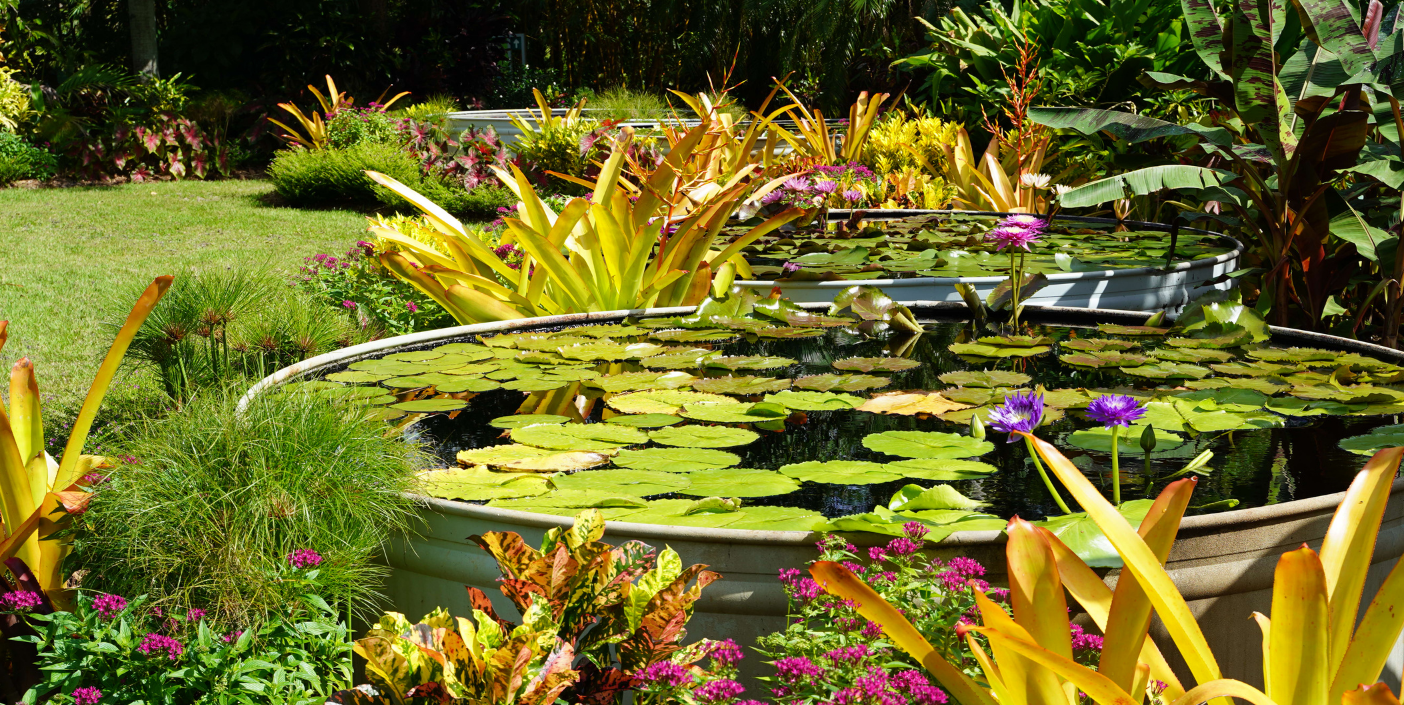
“How big is the flower?”
Aquatics Area Manager Kathy Cahill glances toward Danny Cox, Senior Horticulture Manager, as he slips a measuring stick beneath a lilac-colored waterlily.
“Five-and-a-half inches,” he replies. She logs the measurement, one data point of many the pair will record this August afternoon. For the third year, Naples Botanical Garden is hosting the International Waterlily & Water Garden Society’s New Waterlily Competition, and our staff’s responsibilities include careful record keeping, via notes and photos, on the lilies’ size, appearance, health, and performance for use in adjudication.

The New Waterlily Competition is the world’s premiere event for waterlily hybridizers. Part scientists, part artists, these floral experts combine the genetics of existing plants in the hope of creating a spectacular new variety distinct for its color, shape, size, or other characteristics.
Now is the ideal time to see them. The waterlilies, which hybridizers send to the Garden as plants, tubers or rhizomes, have reached their maturity and are producing abundant blooms. They’ll be on display through September, at which point our team will have finished recording data to submit to judges.
“They’re really extraordinary,” Kathy says, pausing to take them in. The competition lilies can be found in nine large tubs in The Grove, a grassy area opposite the Foster Succulent Garden. There are 26 on display, one entry per hybridizer.
The society rotates hosts every four years; this is our third. To host is both an honor and an undertaking. Ornamental waterlilies are perhaps the Garden’s most cultivated plants, requiring significant hands-on tending. For the competition, the host garden takes responsibility for everything from growing the plants to maintaining their health to documenting their life cycles.

“I think it’s worth every effort,” Kathy says. The competition puts our staff in contact with the world’s best growers and gives our guests a chance to experience their creations. “It’s tremendously exciting.”
The competition also calls attention to the Garden’s extensive water garden displays and aquatic plant collections. Our property includes some 60,000 square feet of water gardens, representing about 15% of our cultivated areas. Thanks to our subtropical climate, we display waterlilies year round, more than 450 at a time. Most hybridizers donate their competition entries to the host garden, which will give us an infusion of stunning new plants this fall and allow us to propagate them going forward, adding to our already significant collection.

The competition judges have a list of qualities they are seeking — everything from the uniqueness of a flower’s shape or color to its durability to its fragrance.
“They’re looking for something spectacular. A niche that hasn’t been filled,” Kathy says. Winners will be announced in December.
While the casual viewer can’t rate this year’s competition lilies against pre-existing ones, there are certainly characteristics to consider as you view the display.
Look for:
- Color – Hybridizers frequently focus on creating new colors or color combinations. Look at the pedals, the stamen in the flower’s center, and the lily pads. You’ll notice some flowers are a vibrant, solid hue, and others look as if an artist has brushed them with paint. You’ll see pads in greens and reds, solid and mottled.
- Shape – Are the flowers star-shaped? Cup-shaped? Pointed?
- Height – Do they rest against the water’s surface, or do they rise well above it?
- Size – Are the flowers and pads large or small? Will this plant fit in your home garden pool?
- Number of petals – Some have long, sparse, dramatic petals, and others have layers upon layers of them, akin to a camellia.
Finally, think like an artist as you view the tubs, Danny encourages. Each flower can be seen as an individual portrait or as part of a greater floral canvas.
“Each is a composition unto itself,” he says, “but then, how do they work together (in the tub) or work in the landscape to create a bigger picture?”
Click here for hours, ticketing, and related information.
 About the Author
About the Author
Jennifer Reed is the Garden’s Director of Public Affairs and a longtime Southwest Florida journalist.

